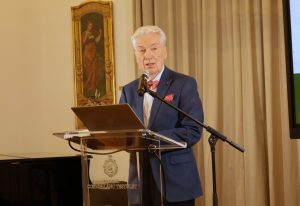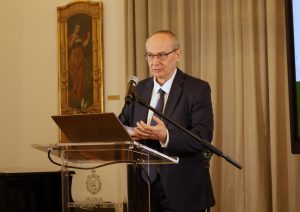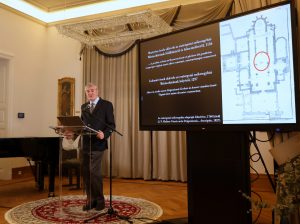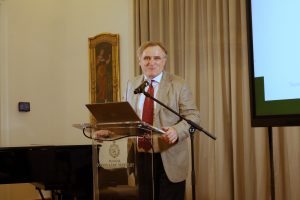The Hungarian Corvin Chain is the second highest state award in Hungary after the Order of St. Stephen of HungaryContinue reading

A conference entitled “European Heritage – Christian Roots” had taken place in Budapest’s famous Róheim Villa on March 12. Among other subjects, the speakers have addressed the topic of the beginnings of Europe built on a common Christian identity.

E Sylvester Vizi. Photo: Hungary Today
The first speaker, Zsolt Adorjáni, a Senior Research Fellow at the Gyula Moravcsik Institute of the Institute for Humanities, delivered his lecture entitled “Forge your tongue on an anvil that knows no lies!” The tradition of poetic speech to the monarch in antiquity and beyond. In this he spoke about the history of poetry in antiquity (mainly Greek), seeking to answer the question of what contents and forms of expression characterize the dialogue between the poet and the ruler. His aim was to allow us to unravel the threads that link the image of the ruler in antiquity and the way he speaks to the ruler with later periods, and to highlight the unity of European culture along this line.

Zsolt Adorjáni. Photo: Hungary Today
The next speaker, Kornél Szovák, Director of the Gyula Moravcsik Institute at the ELKH/HUN-REN BTK has delivered a lecture entitled “In the beginning, the Roman Empire grew by …” The idea of Rome in the medieval Western and domestic tradition. In his view, the Roman cultural heritage has played a decisive role in the centuries of Hungarian history. By the time of the foundation of the Hungarian state, the peoples of Europe had been courting their Roman heritage for centuries, sometimes cherishing it enthusiastically, sometimes rejecting it coldly in the name of Christian asceticism. But the Roman ethos continued to influence the ideals that were in the minds of decision-makers, motivating the actions of the actors and shaping the development of literacy. A decisive moment in this historical journey was the year 1000, when, with the active contribution of the nascent Christian Kingdom of Hungary, a political program was developed in the heart of the continent, which also defined its state framework and its ethno-linguistic structure.

Kornél Szovák. Photo: Hungary Today
Imre Takács, the head of the HUN REN-ELTE Thesaurus Mediaevalis Research Group spoke about “The arrival of Gothicism in Hungary”. His lecture revisited the early relationship and memories of this great period of European art history of French origin and the Kingdom of Hungary. In this period, instead of a single beginning, there were at least two unexpected signs (the medieval Esztergom cathedral) of the arrival of artistic modernity in the late 12th and first thirds of the 13th century, in each case with the background of the French dynastic contact of the Hungarian royal house, the arrival of French queens in Hungary and the work of the entourage that moved in with them.

Imre Takács. Photo: Hungary Today
Professor Péter Tusor, a teacher of Latin at the Faculty of Humanities and Social Sciences of Pázmány Péter Catholic University lectured about “The Papacy in the Early Modern Age”. In his presentation he summarized the survival and transformation of the Roman Empire’s heritage in the early modern period. He also discussed the Roman Papacy’s centralizing tendencies, both on the continent, and in the global arena.

Péter Tusor. Photo: Hungary Today
The host of the event was Prof. Dr. Miklós Maróth, while Prof. Dr. E. Sylvester Vizi had delivered the welcoming speech. They are both members of the Hungarian Corvin Chain’s Board.

Miklós Maróth. Photo: Hungary Today
Featured Image: Hungary Today